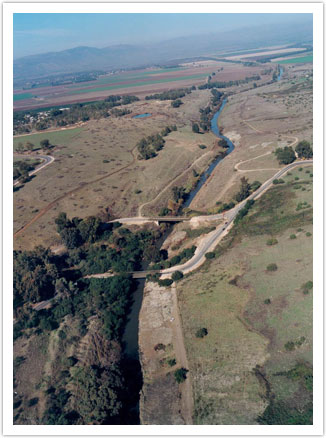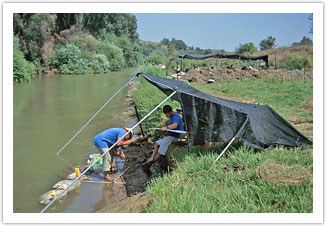 |
| Aerial view looking north toward the Benot Ya‘aqov Bridge and the Hula Valley. |
The Gesher Benot Ya‘aqov Acheulian Site Project
The multidisciplinary research project of the Gesher Benot Ya‘aqov Acheulian site is concerned with excavations, analysis and the publication of results. The site has been investigated by archaeologists of the Hebrew University since the 1930s. The present project is based on seven field seasons (1989-1997) that took place under the directorship of Naama Goren-Inbar.
The site is located in the Dead Sea Rift, a segment of the African Great Rift System, south of the Hula Valley. It stretches along 3.5 km of the bed and both banks of the River Jordan. Excavations revealed a series of waterlogged tectonically tilted layers that were deposited in the paleo-Lake Hula and on its shores. The wealth of archaeological finds deposited on the shores of this lake represents the environment and behavior of hominins that occupied this landscape. The fieldwork exposed deposits that document a series of paleoclimatic fluctuations extending over 100,000 years and dated to the Lower and Middle Pleistocene, some 790,000 years ago.
Pleistocene milestones on the Out of Africa
The site is one of the earliest landmarks of cultural and biological exchange between biogeographical zones, particularly those situated along the Levantine Corridor. The continuous record contributes immensely to our knowledge of the history of human occupation along the Out of Africa migration route, a pivotal aspect in both location and timing of the history of human evolution. The communities had a very well-defined African tradition – the Acheulian culture.
 |
| Excavation on the Jordan River bank. |
A Multidisciplinary Study
The archaeological finds comprise stone tools, fossil animal bones and unique assemblages of wood, bark, fruits and seeds, originating in multiple occupations. While the biological material supplies unparalleled scientific data for the reconstruction of the environment, the archaeological data provide a unique cultural perspective on the tools and technological abilities of the hominins. The overall synergetic analyses of the results supply a rare opportunity to achieve insights into the particulars of early human adaptations in Eurasia and the realm of behavioral patterning.
Studies dedicated to the material culture show that these archaic humans had highly developed abilities. The analyses yielded unique evidence (the earliest in Eurasia) for their control of fire. Hominins had a deep knowledge of animal behavior, as expressed by the number of animal species that they were able to exploit. Their treatment of the carcasses is comparable to that known from sites occupied by modern humans.
|